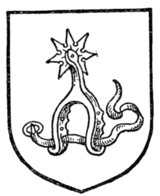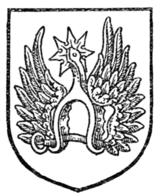at its point by an annulet argent" represents the French family of Danby.
Spurs (Fig. 513) occur in coat armour as such in the arms of Knight and Harben, and also occasionally "winged" (Fig. 514), as in the crest of Johnston.
Spur-Rowels, or Spur-Revels, are to be met with under that name, but they are, and are more often termed, "mullets of five points pierced."
Examples of Stirrups are but infrequent, and the best-known one (as regards English armory) is that of Scudamore, while the Polish Counts Brzostowski bore: "Gules, a stirrup argent, within a bordure or."
 Fig. 513.—Spur. |
 Fig. 514.—Winged spur. |
 Fig. 515.—Sword. |
Stones are even more rare, though a solitary example may be quoted in the arms of Staniland: Per pale or and vert, a pale counterchanged, three eagles displayed two and one, and as many flint-stones one and two all proper. The "vigilance" of the crane has been already alluded to on page 247. The mention of stones brings one to the kindred subject of Catapults. These engines of war, needless to say on a very much larger scale than the object which is nowadays associated with the term, were also known by the name balistæ, and also by that of swepe. Their occurrence is very infrequent, but for that very reason one may, perhaps, draw attention to the arms of the (English) family of Magnall: "Argent, a swepe azure, charged with a stone or."
Swords, differing in number, position, and kind are, perhaps, of this class of charge the most numerous. A single sword as a charge may be seen in the shield of Dick of Wicklow, and Macfie, and a sword entwined by a serpent in that of Mackesy. A flaming sword occurs in the arms of Maddocks and Lewis. Swords frequently figure, too, in the hands or paws of supporters, accordingly as the latter are human figures or animals, whilst they figure as the "supporters" themselves in the unique case of the French family of Bastard, whose shield is cottised by "two swords, point in base." The heraldic sword is represented as Fig. 515, the blade of the dagger
